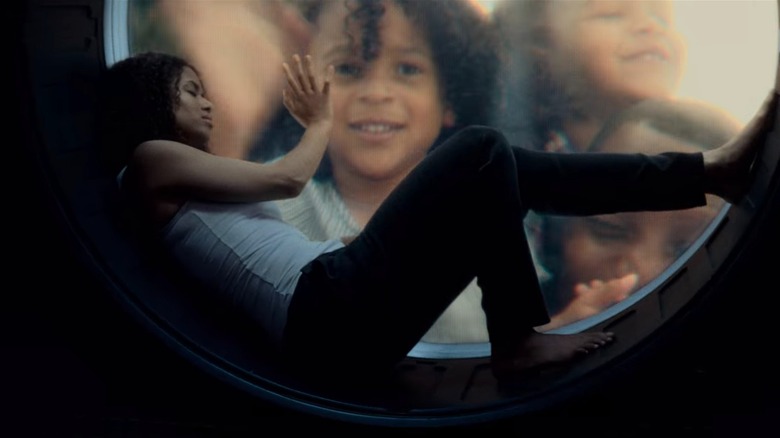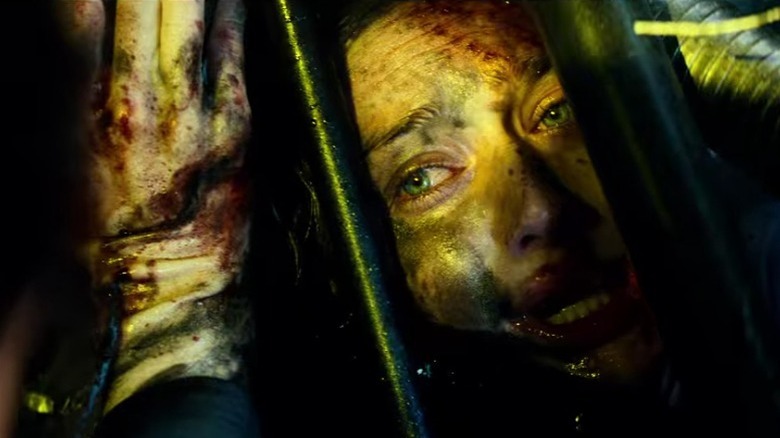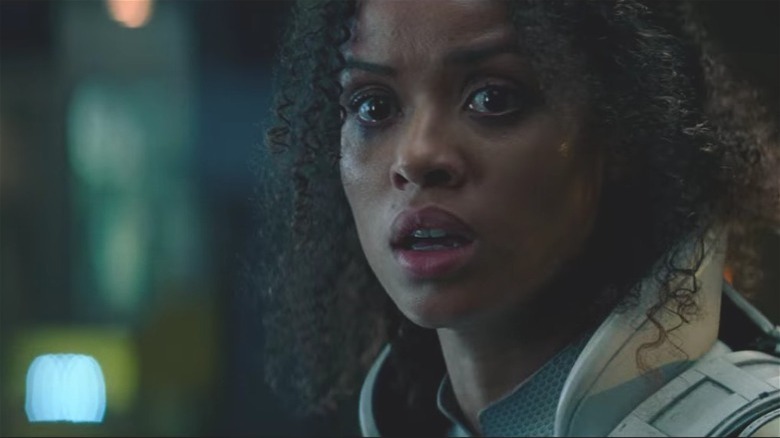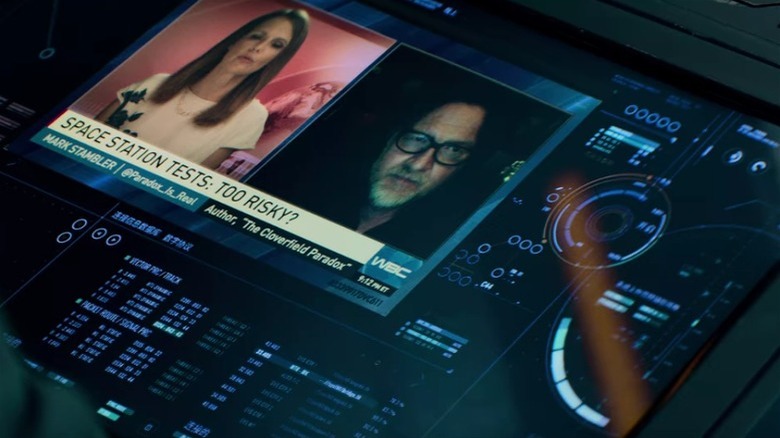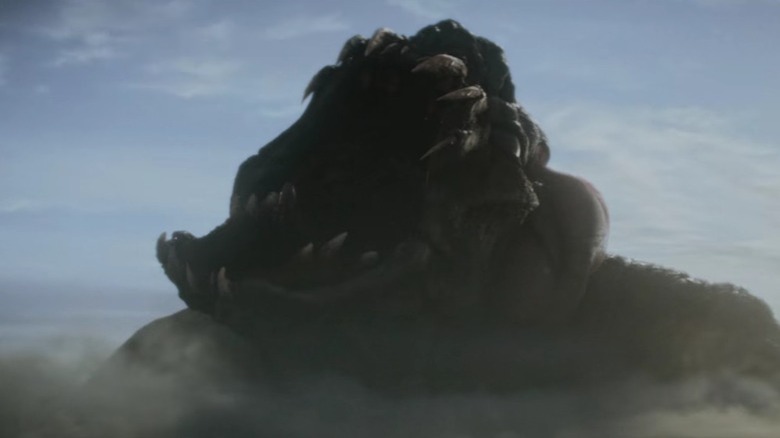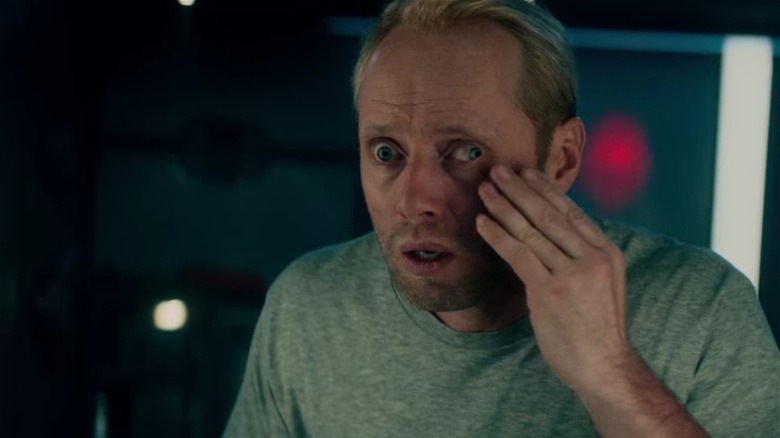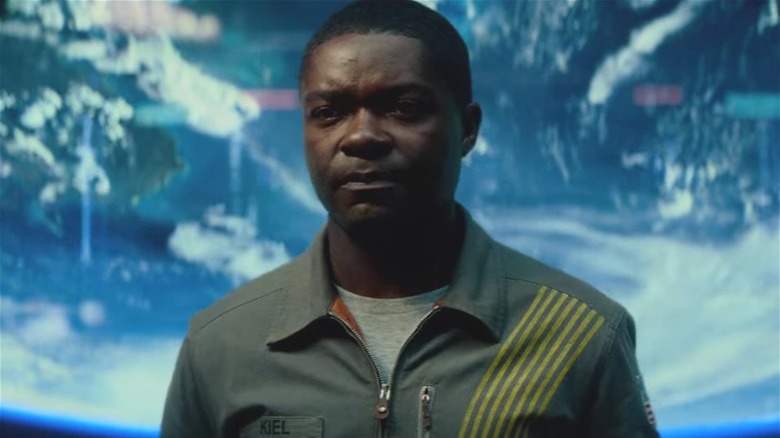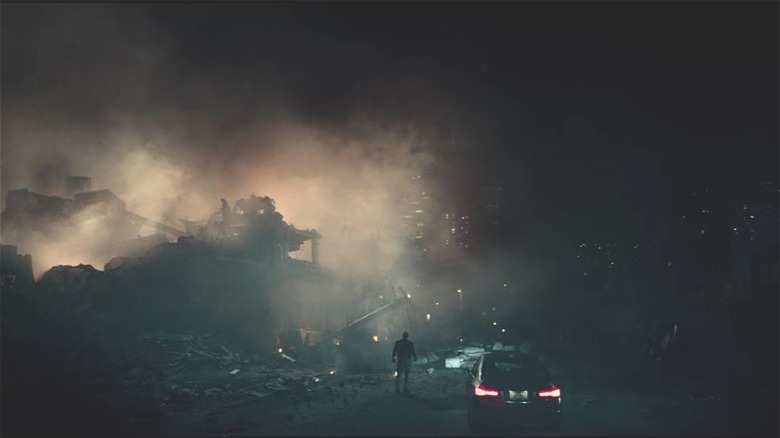The Cloverfield Paradox Ending Explained: Bringing It All Together
On Super Bowl Sunday 2018, director Ava DuVernay tweeted, "#FilmTwitter is going to explode tonight. Something is coming that I can hardly believe. Lawd. History in the making." She was teasing Netflix's surprise release of "The Cloverfield Paradox," the third installment in the hit sci-fi and horror franchise. The film hadn't officially been announced, but it dropped on the streaming service right after the game ended, sending shockwaves through the entertainment industry. Unfortunately — perhaps in part because the hype reached wild levels in the hours leading up to the film's release — critics were not fans of the movie. DuVernay has since deleted her tweet.
"The Cloverfield Paradox" is a relatively derivative sci-fi thriller. It spends much of its runtime explaining what's going on, spelling out the rules of its plot mechanics. At the same time, its story can be tough to follow. It also bends over backwards to explain the rest of the "Cloverfield" franchise, which up until this point had been a series of films that were connected thematically, but not via any kind of continuity.
Removed from the hype-and-instant-letdown cycle, however, the movie holds up fine. The cast is incredibly stacked, and everyone gives it their all. While the movie does feel formulaic, it's well-executed, and it's never less than engrossing. As the "Cloverfield" franchise looks toward the future, let's revisit the end of "The Cloverfield Paradox" — just what did that monster mean, anyway?
What you need to remember about the plot of The Cloverfield Paradox
In "The Cloverfield Paradox," Earth is out of resources, and international tensions run high. Hamilton (Gugu Mbatha-Raw) joins an experimental mission in space, where her team tries to build a particle accelerator called "the Shepard" that could produce unlimited energy for the planet. After more than a year of failed tests, the crew of the Cloverfield Space Station manages to successfully start the accelerator ... until it melts down. When they stabilize the ship, the Earth has disappeared.
Strange things begin to happen around the station. Russian astronaut Volkov (Aksel Hennie) goes mad and uses a 3D printer to make a gun, convinced that his German colleague, Schmidt (Daniel Bruhl), intentionally sabotaged the collider. Irish scientist Mundy (Chris O'Dowd) gets partially sucked into a wall, and his arm vanishes ... then reappears, detached, with a mind of its own. A woman named Jensen (Elizabeth Debicki) suddenly appears in the wall, power cables running through her body; she claims to be a member of the crew. Everyone decides that firing the accelerator must have knocked them into an alternate dimension.
Meanwhile, on Earth, Hamilton's husband, Michael (Roger Davies), finds his city smashed to rubble by a series of explosions. Something massive has attacked, glimpsed only as a shadow moving through a cloud of smoke. Michael rescues a young girl (Clover Nee) from a flattened home and takes her down into an emergency bunker to wait out the catastrophe.
What happened at the end of The Cloverfield Paradox?
The surviving crew plans to fire the Shepard one final time, hoping it will bring them back home. That's when Jensen goes rogue, aiming to keep the Shepard in her dimension so that she can save her own Earth. First, Jensen knocks Hamilton out, strapping her into an escape pod. Then, she shoots and kills Monk (John Ortiz). Jensen goes after Schmidt next, but she fails to kill him before Hamilton wakes up. After brawling with Jensen for control of the 3D-printed gun, Hamilton shoots out a window. The resulting vacuum sucks Jensen out into space, killing her. Hamilton survives and patches Schmidt up, and together they manage to power up the particle accelerator.
And it works! In the film's final moments, the station returns to its original location in its home dimension. Down on Earth, Hamilton's husband Michael receives a call letting him know the missing space station has been located. Instead of overjoyed that his wife is back, though, he's horrified to hear that the survivors will soon land off the coast of Delaware. "Tell them not to come back!" he screams over shots of the escape capsule descending through the atmosphere.
Then, just as Hamilton's pod plummets back down to Earth, a monster's head bursts through the clouds, roaring. Cut to black; roll credits.
What is 'the Cloverfield paradox,' exactly?
To understand how Cloverfield Station crew's actions affect the events on Earth, you have to pay attention to the news broadcast that the team watches toward the beginning of the film. In the movie, Donal Logue plays Mark Stambler, a man who is convinced that turning on the particle accelerator is incredibly dangerous. "Every time they test it, they risk ripping open the membrane of space-time," he says, "smashing together multiple dimensions, shattering reality — and not just on that station. Everywhere." He then predicts what might happen: "This experiment could unleash chaos the likes of which we have never see. — monsters, demons, beasts from the sea."
He's treated like a crank, but that's exactly what happens. Jensen guesses that their successful test managed to "crash a Higgs Boson" — the so-called "god particle" — and sent them into a different dimension. The "paradox," then, is that humans who originated in one dimension exist in another — one where they already exist. Typically, something can't be in two places at once; thus, it's a paradox.
In the end, the monster roaring above the clouds shows us that Stambler and Jensen's assumptions were correct. Testing the Shepard did indeed unleash chaos on Earth. Further, firing the accelerator again in order to return the surviving crew members to their original dimension didn't reverse all of its effects. Reality has fractured.
How does the end of The Cloverfield Paradox connect to the other Cloverfield movies?
How does that final shot of "The Cloverfield Paradox" connect to the rest of the franchise? Easily — if you've seen the original "Cloverfield." The first film in the series was about a beast attacking New York City, and the monster in that movie looks an awful lot like the one terrorizing Earth in "The Cloverfield Paradox."
But there's one crucial difference: scale. This beast is massive, orders of magnitude larger than the creature from the original film. This suggests two things. First, it redefines our understanding of the monster from the first movie, suggesting that it was a younger, clumsier version of this bigger beast. Second, and perhaps more importantly, it tells us that "The Cloverfield Paradox" doesn't depict the same attack we witnessed in "Cloverfield."
We can see what's going on here. "Cloverfield," "10 Cloverfield Lane," and "The Cloverfield Paradox" exist in their own universes, just as Jensen existed in a reality separate from the one where the crew first booted up the Shepard. That action had a ripple effect not just on the universes seen in "The Cloverfield Paradox," but on the universes from those other movies, too. In other words, "The Cloverfield Paradox" tells us why monsters attacked in "Cloverfield" and "10 Cloverfield Lane": The crew aboard the Cloverfield Space Station broke everything everywhere, all at once.
The Cloverfield Paradox's alternate ending
"The Cloverfield Paradox" began its life as a script by Oren Uziel called "The God Particle." Originally, "The God Particle" had nothing to do with the "Cloverfield" franchise; instead, it was meant to be a standalone sci-fi film. The screenplay has been floating around online for years, and a read confirms that, while the bones of the story were the same, the details were very different.
Like "The Cloverfield Paradox," "The God Particle" is about a group of astronauts on a long-term mission in space who are trying to build a particle accelerator while the planet below devolves into war. As in the film we eventually got, testing the accelerator makes the Earth vanish, leaving the crew stranded. Other than some character names, that's where the similarities end. In "The God Particle," a space shuttle full of European astronauts shows up, and the Americans are picked off one by one. Rather than the reality-bending tale we get in "The Cloverfield Paradox," it's more like a slasher movie or a whodunnit — imagine an Agatha Christie mystery set in space.
In "The God Particle," the particle accelerator is revealed to be a military weapon. The Americans realize they are on the opposite side of the sun from the Earth, and they destroy the bomb so that it can't fall into European hands. After a protracted battle, two American survivors steal the European space shuttle and head back to Earth. There are no alternate universes, and no monsters.
What has the cast and crew of The Cloverfield Paradox said about the ending?
When "The Cloverfield Paradox" dropped on Netflix, there was much chatter online about the fact that the movie had been filmed under an alternate title and was altered to become a "Cloverfield" movie in post-production. Speaking with The Playlist, Gugu Mbatha-Raw chose her words carefully as she revealed that she found out what happened to her character, vis-a-vis the giant monsters, along with the rest of the world. "How do I put this?" she mused. "... There were so many things that evolved in the movie. I had lots of surprises watching it myself."
Producer JJ Abrams and director Julius Onah went into more detail about the ending in a joint interview with NME. Onah said the inclusion of the monster was what sold him on connecting his film with the wider "Cloverfield" universe. "The thing that really excited me was the way the monster appears at the end," he recalled. "When that idea first came up, it was just nutty and really cool and I thought that was really fun, to end on a note you wouldn't quite expect and to find a way to tie it back to the other stories yet still create a sense of possibility."
Abrams expanded on Onah's excitement. "What I liked was the idea that a future story could be the origin for something in the past and be a catch-all for a bunch of weirdness," he said.
What the end of The Cloverfield Paradox could mean for the franchise
The "Cloverfield" franchise has never done things by the book, so it's no surprise that the significance of "The Cloverfield Paradox" remains unclear. The movies were once talked about as a sort of anthology series, but "The Cloverfield Paradox" attempted to explain why reality went wonky in the other films. So, will future "Cloverfield" movies have to grapple with what went down on the station from "The Cloverfield Paradox"? At this point, we simply don't know.
Instead, all we have to go on are the words of J.J. Abrams in the above interview with NME. "Now that we've done this crazy movie, it opens up the possibility of alternate everythings," he explained. "But obviously if you say there are no rules then that's not good either. So you want to figure out what it means." Ultimately, Abrams concluded, "I think every movie itself needs to have its own set of rules within it." In other words, in 2018, the "Cloverfield" braintrust wasn't sure what was coming next.
What's clear, however, is that something is on the way. In May 2023, the Slusho website that was part of the first film's viral marketing campaign came back to life. Reportedly, the next film might be a direct sequel to the original "Cloverfield"; we probably won't know for sure, though, until it's released, either via surprise-drop or some other method.
